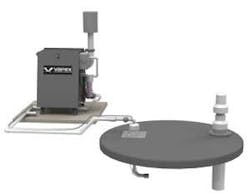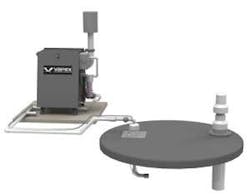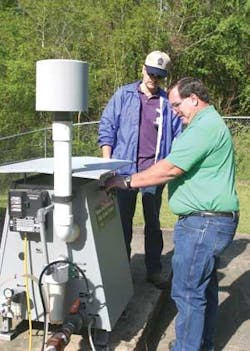Hydroxyl Fogging Technology Helps Utility Eliminate Sewage Odors
Hot Springs, AR, lift station manager Craig Stevens knows when his system has odor problems by the number of phone calls he receives from upset citizens. In the last few years, however, those complaints have been declining.
Since 2003, Hot Springs has been regularly installing hydroxyl ion fogging technology in its pump station wet wells to oxidize hydrogen sulfide and eliminate H2S odors.
“We’ve had real good results,” said Stevens of the odor control fogging units, developed and marketed under the brand name O-Mega by Vapex Inc., Orlando, FL. “We put the first two into our main stations, and now have a total of nine units in operation. We try to budget for 1-2 more every year.”
The Hot Springs wastewater collection system consists of over 600 miles of sewers and 110 pumping stations which collect and transport wastewater from 25,000 customers throughout the city and portions of Garland County. The flow is processed at two treatment facilities–the 12 mgd main plant and a new 1 mgd sequencing batch reactor plant that started up in 2008.
The area’s hilly terrain and numerous recreational lakes create special challenges for Stevens and his team. The large number of lift stations and 4,000 simplex and duplex sewage grinders in the system can be odor “hot spots,” and many of them are located in residential neighborhoods or close to prime waterfront property. When a unit smells bad, the neighbors let Stevens and his assistant Tony Burkes know.
In response, Hot Springs has pursued a range of potential solutions.
“We’ve tried a whole gamut of things to control or eliminate odors in our lift station wet wells,” Stevens said. “Concentrated bleach, ozonation, hydrogen peroxide, you name it.”
After visiting New Orleans, where several O-Mega units are in operation, Stevens and Hot Springs decided to try the Vapex fogging technology and ordered the first two units.
How they work
In the O-Mega units, a unique atomizing nozzle generates the hydroxyl ion fog which is sprayed into odorous spaces. The fog fills the headspace and chemically reacts with the vapor phase hydrogen sulfide, destroying the odorous compounds at a much faster rate than possible with chlorine. The structure acts as the reaction chamber, and the reacted mist condenses back into the water stream. There is no need to withdraw odorous air from the structure and pass it through a separate odor control scrubbing process.
In addition to relatively low capital and operating costs when compared with other odor control methods, the O-Mega units are compact, use no expensive scrubbing chemicals, and can reduce H2S corrosion inside the structure. The hydroxyl fog also helps break down grease and kill biofilm.
The units come in a variety of sizes, with a range of nozzle output rates and coverage areas. Introduced to the wastewater market earlier this decade, hundreds of the odor control units currently serve municipalities across the United States.
At Hot Springs, eight of the nine units are installed in pump station wet wells, while one is applied to an open trench that has been covered to form a confined area to contain the fog. The trench contains a bar screen and compactor.
Installation has been simple and power consumption minimal, Stevens said.
“We set up each new unit, drill core holes for the nozzle and the vent, and bring in an electrical receptacle and water source. Vapex field service personnel come in to help us start the unit up.”
Maintenance includes changing out the air filter every two to three months, cleaning the nozzle, and running a cleaning fluid through the whole system about once a month to remove any water deposits.
“I’d say it’s one-tenth of the maintenance of our old enzyme units, with results that are two to three times better,” Stevens said.
At one location – Hot Springs Creek – it was common for grease to build up into a thick coating on top of the water.
“After six months of operation of the hydroxyl fogging unit, the grease was completely dissolved and you could see the water when you looked into the wet well from the top,” Stevens said.
At another pump station, the fogging technology has arrested deterioration of the concrete walls caused by H2S corrosion.
And in addition to fewer phone complaints about odors, Stevens has enjoyed a change in the content of some of the calls. He reports, “One lady who used to call us all the time about problems, called us recently to thank us for taking care of them.” WW


